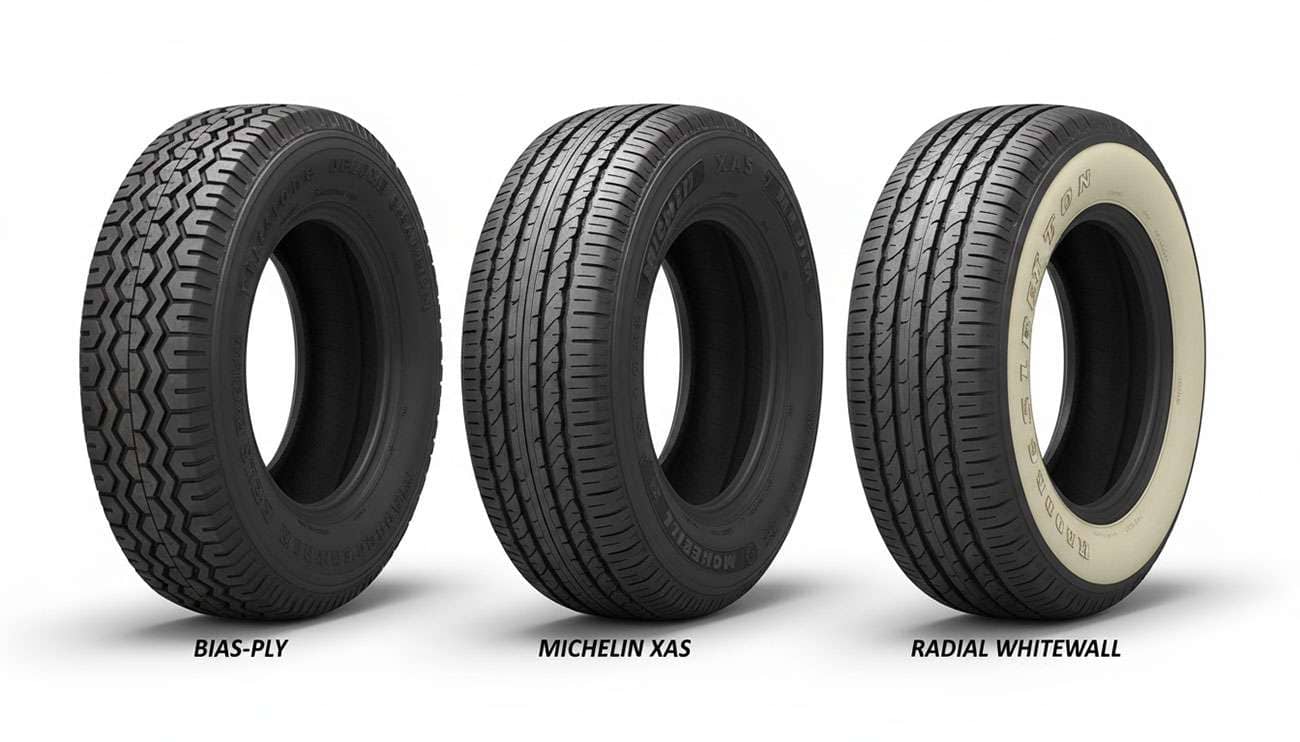
Classic car tires are essential components that define both the authentic appearance and driving experience of vintage automobiles. Understanding the right tire selection becomes crucial for the approximately 890,000 classic car enthusiasts in the United States actively engaged in restoration projects. The classic car parts market reached $1.81 billion in retail sales in 2022, with tires representing a significant portion of these specialized purchases.
When selecting classic car tires, you'll encounter three main categories that dominate the vintage automobile world. Bias-ply tires deliver authentic period-correct feel and appearance but sacrifice modern handling characteristics. Radial tires provide superior performance for regular driving with improved safety and longevity. Bias-look radials offer the perfect compromise, combining vintage esthetics with modern construction benefits. Each type features distinct carcass designs that create unique contact patches with the road, plus period-correct tread patterns that capture essential historical details.
The right classic car tires make a substantial difference in your vehicle's performance and safety. Proper tire selection can dramatically improve braking distance, enhance handling in wet conditions, and provide better overall safety. Pricing varies considerably across the market - expect to invest anywhere from $72 to over $330 per tire, depending on brand and specifications. Remember that even tires appearing perfect can fail if they're old, making it essential to choose fresh tires from trusted sources.
At Performance Plus Tire, we understand that selecting the right tires for your classic automobile requires balancing historical accuracy with your specific performance needs and driving habits.
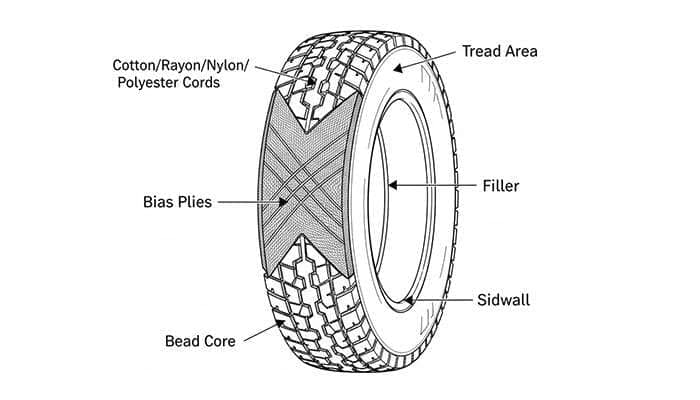
Bias-ply tires represent the original tire technology that dominated American automotive manufacturing from the early 1900s through 1975. These tires provide the most authentic driving experience for vintage automobiles, making them essential for enthusiasts prioritizing historical authenticity and period-correct restoration projects.
The distinctive character of bias-ply tires comes from their unique internal structure. Multiple layers of fabric plies run diagonally from one bead to the other at angles between 30-45 degrees. Each ply is positioned at an opposing angle, creating the characteristic crisscross pattern that gives these tires their name - the plies literally run "on the bias" across the tire [9, 10].
Early tire manufacturers evolved their materials over decades:
Cotton cords (1900s-1915)
Rayon construction (1930s)
Nylon reinforcement (1943 onwards)
Polyester compounds (modern reproductions)
The number of plies directly determines strength and load capacity. Most passenger car applications use four layers of ply cord, while truck tires incorporate additional layers for heavy-duty durability. High-performance variants sometimes include specialized reinforcement - aircraft bias tires feature inter-tread reinforcing fabric (ITF) for enhanced high-speed stability and casing protection.
Visually, bias-ply tires display a squared-off shoulder profile compared to the rounded appearance of radial designs. They feature taller sidewalls and narrower contact patches, creating the classic stance that defines vintage automobile appearance.
The crisscross construction creates unique driving characteristics that directly impact your classic car experience. These tires deliver equal strength across both sidewall and tread areas since they share identical construction. This uniform distribution provides excellent puncture resistance and sidewall durability.
Road feel represents the most noticeable difference from modern tires. Bias-ply construction tends to track road ruts and pavement breaks, creating the "wandering" sensation that characterized original vehicle handling. While this might feel unsettling initially, it faithfully reproduces how your classic car performed when it left the factory.
Heat generation presents certain limitations during extended driving:
Higher heat buildup compared to radial alternatives
Increased rolling resistance affecting fuel economy
Accelerated wear rates, especially on highways
Greater energy consumption during long trips
Bias-ply tires are susceptible to flat-spotting when vehicles sit stationary for extended periods. The contact area develops a flat section, causing vibration and noise until the tire rounds out through driving.
These tires excel in specific applications. They conform exceptionally well to rough terrain, providing compliant off-road performance. Their stiff construction maintains the original ride characteristics that authenticity-focused enthusiasts value.
Bias-ply tires serve enthusiasts who prioritize absolute historical accuracy over modern performance benefits. These tires represent the correct choice for American vehicles manufactured through 1975. European manufacturers transitioned to radial construction during the 1950s, while American companies continued bias-ply production until the mid-1970s.
Ideal applications include:
Concours-level restorations: Show cars and museum-quality builds benefit from period-correct appearance that judges expect, including authentic sidewall designs and tread patterns.
Traditional hot rod builds: Period-specific customs from the 1950s-1970s maintain historical accuracy with bias-ply construction. Traditional hot rod and gasser scenes particularly favor this approach.
Collector vehicle originality: Owners prioritizing absolute authenticity over driving comfort choose bias-ply tires for the genuine vintage experience.
Quality manufacturers continue producing bias-ply tires for the classic car market. Coker Tire reproduces legendary brands including Firestone, BF Goodrich, and US Royal with authentic tread patterns and sidewall styling. Available options include wide whitewalls, narrow whitewalls, raised white letters, redlines, and goldlines matching specific eras.
Choosing bias-ply tires means accepting certain trade-offs for authenticity. While they don't match radial alternatives for highway stability or longevity, they provide the genuine driving connection to automotive history that dedicated enthusiasts value most.
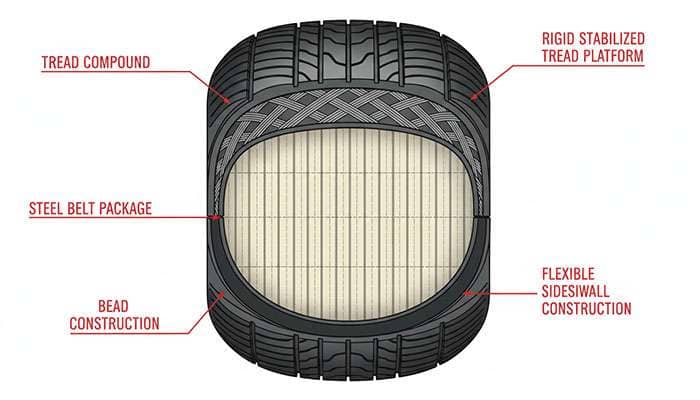
Radial tires revolutionized the automotive industry by introducing superior construction that delivers enhanced performance, safety, and longevity. For classic car owners who drive their vehicles regularly, radial tires offer compelling advantages over traditional bias-ply designs. The construction methodology separates sidewall and tread functions, creating optimized performance characteristics that benefit both daily drivers and weekend enthusiasts.
The fundamental difference in radial tire design lies in how the internal plies are positioned. Instead of running diagonally across the tire, the cords run perpendicular to the direction of travel - directly from one bead to the other at 90-degree angles. This radial orientation gives these tires their distinctive name.
The construction typically features:
Radial body plies: Usually one or two layers running perpendicular to the direction of travel
Steel belt reinforcement: Multiple steel belts positioned circumferentially under the tread
Flexible sidewalls: The perpendicular ply arrangement allows sidewalls to flex independently from the tread
Stabilized tread area: Steel belts create a rigid platform that maintains consistent road contact
This engineering approach creates distinct functional zones within the tire. The flexible sidewalls absorb road irregularities and provide comfort, while the reinforced tread area maintains optimal contact with the pavement. The steel belt construction stabilizes the tread, reducing squirm and delivering predictable handling characteristics.
Modern radial tires for classic cars often incorporate period-appropriate tread patterns and sidewall designs. Manufacturers blend contemporary construction methods with vintage esthetics, creating tires that look correct for the era while providing modern performance benefits.
Radial construction delivers measurable performance improvements across multiple driving conditions. The separated sidewall and tread functions create characteristics that directly benefit regular driving:
Superior handling and stability: The rigid tread platform maintains consistent road contact through corners, providing predictable steering response. Radial tires resist the "wandering" sensation common with bias-ply designs, creating confidence-inspiring straight-line stability.
Enhanced braking performance: The larger, more consistent contact patch improves braking efficiency in both dry and wet conditions. This translates to shorter stopping distances and increased safety margins.
Improved fuel economy: Radial construction reduces rolling resistance by 20-30% compared to bias-ply alternatives. Lower rolling resistance means your classic car consumes less fuel during operation, making longer trips more economical.
Extended tread life: The stable tread platform wears more evenly, significantly increasing tire longevity. Radial tires typically last 2-3 times longer than bias-ply designs under similar driving conditions.
Better heat management: The construction dissipates heat more effectively, reducing the risk of heat-related failures during extended highway driving. This makes radial tires particularly suitable for long-distance touring.
Wet weather capability: Modern tread compounds combined with optimized tread patterns provide superior water evacuation and wet-weather traction. This safety advantage proves especially valuable for classic cars driven in varying weather conditions.
The ride quality differs noticeably from bias-ply tires. Radial construction absorbs road imperfections more effectively, delivering a smoother, more compliant ride that reduces driver fatigue on longer journeys.
Radial tires excel when performance, safety, and regular driving take priority over absolute period correctness. These situations represent ideal applications:
Regular driving and touring: Classic cars used for weekend drives, car shows, or cross-country tours benefit significantly from radial tire advantages. The improved handling, fuel economy, and heat management make these trips safer and more enjoyable.
Wet weather driving: If you drive your classic car in rain or on damp roads, radial tires provide crucial safety benefits through superior wet-weather traction and hydroplaning resistance.
Highway travel: Extended highway driving generates significant heat in tires. Radial construction manages this heat more effectively, reducing the risk of tire failure during long-distance travel.
Late-model classics: Vehicles from the late 1970s onward came equipped with radial tires from the factory. Using radials maintains period correctness while providing appropriate performance characteristics.
Resto-mod builds: Classic cars modified with modern drivetrains, suspension upgrades, or increased power output require the superior handling and safety characteristics that radial tires provide.
Several manufacturers produce radial tires specifically for classic cars. Coker Tire offers extensive radial options with period-appropriate styling. Michelin's Classic line combines modern radial technology with vintage tread patterns. Pirelli Collezione produces radials specifically engineered for classic sports cars with authentic period designs.
Choosing radial tires means prioritizing driving experience and safety over absolute originality. For enthusiasts who regularly enjoy their classic cars on modern roads, this represents a practical compromise that significantly enhances the driving experience without sacrificing visual authenticity.
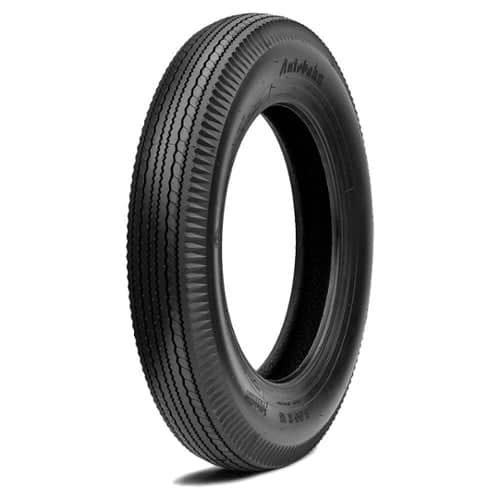
Bias-look radial tires represent the perfect solution for classic car enthusiasts seeking the best of both worlds - authentic vintage appearance combined with modern radial tire performance. These specialized tires deliver the visual authenticity that show judges and purists demand while providing the safety and handling characteristics that regular drivers require.
The engineering innovation of bias-look radial tires lies in their dual-purpose design approach. Internally, these tires feature complete modern radial construction with perpendicular body plies and circumferential steel belts. This provides all the performance advantages associated with radial technology - superior handling, improved fuel economy, and extended tread life.
The critical difference appears in the sidewall and tread design. Manufacturers carefully replicate the visual characteristics of authentic bias-ply tires:
Squared-off shoulder profile: The tire shape mimics the distinctive squared appearance of traditional bias-ply designs
Period-correct tread patterns: Authentic reproductions of original equipment manufacturer (OEM) tread designs
Proper sidewall proportions: Taller sidewalls that match the aspect ratios common in specific eras
Authentic sidewall markings: Period-appropriate branding, sizing information, and decorative elements
Correct sidewall styling: Available with whitewalls, redlines, raised white letters, or other era-specific decorative elements
From an external visual perspective, these tires appear indistinguishable from authentic bias-ply designs. The squared shoulder profile and period-correct styling satisfy even discriminating show judges while the internal radial construction delivers contemporary performance benefits.
Leading manufacturers have invested significant research into perfecting this hybrid approach. Diamond Back Classics specializes in bias-look radial tires with extensive size offerings. Coker Tire produces the BFGoodrich Silvertown Radial line that combines 1960s-era tread patterns with modern radial construction.
Bias-look radial tires deliver authentic radial tire performance despite their traditional appearance. The internal construction determines actual driving characteristics, not the external styling.
Handling and stability: These tires provide the predictable, confidence-inspiring handling associated with radial construction. The rigid tread platform maintains consistent road contact, eliminating the "wandering" sensation common with genuine bias-ply tires.
Improved safety margins: Modern radial construction delivers superior wet-weather traction and shorter braking distances compared to authentic bias-ply alternatives. This safety advantage proves particularly valuable for classic cars driven regularly on contemporary roads.
Reduced flat-spotting: The flexible radial sidewall construction resists the flat-spotting issues that plague traditional bias-ply tires during storage. This means smoother operation after the vehicle has been sitting, without the vibration and noise associated with flat-spotted bias-ply designs.
Heat management: Radial construction dissipates heat more effectively than bias-ply designs. This characteristic makes bias-look radials suitable for extended highway driving without the heat-related concerns that limit genuine bias-ply tire usage.
Extended service life: The stable tread platform and even wear characteristics mean these tires last significantly longer than authentic bias-ply alternatives - typically 40,000-50,000 miles under normal driving conditions compared to 15,000-25,000 miles for traditional bias-ply designs.
Fuel efficiency: Lower rolling resistance reduces fuel consumption by approximately 20-30% compared to genuine bias-ply tires. For enthusiasts who drive their classics regularly, this represents meaningful cost savings over time.
The ride quality closely resembles modern radial tires rather than traditional bias-ply designs. While they may not precisely replicate the original factory ride characteristics, the improved comfort and reduced driver fatigue benefit regular driving scenarios.
Bias-look radial tires serve enthusiasts who refuse to compromise between authenticity and performance. These situations represent ideal applications:
Show cars that get driven: Classic cars displayed at shows but also used for regular driving benefit from authentic appearance that satisfies judges combined with safe, reliable performance for the journey home.
High-value classics: Expensive or significant vehicles merit the enhanced safety and performance that modern radial construction provides while maintaining investment value through period-correct appearance.
Daily-driven classics: Enthusiasts who use their classic cars for regular transportation require reliable, safe tires that don't compromise the vehicle's authentic appearance.
Long-distance touring: Classic car tours covering hundreds or thousands of miles demand the reliability, heat resistance, and fuel efficiency that radial construction delivers. Bias-look radials provide these benefits without sacrificing visual authenticity.
Mixed-use vehicles: Classic cars participating in both show events and driving events benefit from tires that meet both visual authenticity standards and performance requirements.
Wet weather driving: If you drive your classic in varying weather conditions, the superior wet-weather traction of radial construction provides crucial safety benefits while maintaining period-correct appearance.
Pricing for bias-look radial tires typically ranges from $262 to $440 per tire, positioning them at a premium compared to either authentic bias-ply or standard radial alternatives. This price reflects the specialized manufacturing required to combine modern construction with period-correct styling.
For many classic car enthusiasts, bias-look radial tires represent the optimal solution. They eliminate the compromises inherent in choosing between authenticity and performance, delivering both in a single package. The investment pays dividends through enhanced safety, improved driving experience, and maintained visual authenticity that preserves the vehicle's character and value.
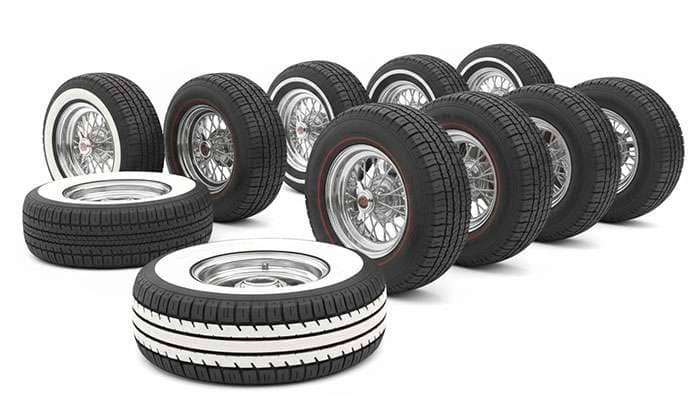
Whitewall and redline tires represent distinctive styling elements that defined specific automotive eras. These decorative sidewall treatments transformed functional rubber components into visual statements that completed a vehicle's period-correct appearance. Understanding the historical context and available options helps you select the right styling for your classic automobile.
Whitewall tires dominated American automotive styling from the 1930s through the 1950s. Originally developed as a byproduct of tire manufacturing - the natural white color of untreated rubber showing through before carbon black became standard throughout - whitewalls evolved into deliberate design elements that signified luxury and sophistication.
The width of whitewalls reflected changing fashion trends across decades:
Wide whitewalls (3-4 inches): Popular during the 1940s-1950s, particularly on luxury vehicles and high-end models
Medium whitewalls (2-3 inches): Common throughout the 1950s-1960s on mainstream American automobiles
Narrow whitewalls (3/4-1 inch): Emerged in the 1960s-1970s as styling became more understated
Ultra-narrow whitewalls: Late 1970s-1980s luxury vehicles featured minimal white pinstripes
Redline tires became synonymous with American muscle car culture during the 1960s and early 1970s. These tires featured thin red stripes running around the sidewall, creating a sporty appearance that complemented performance-oriented vehicles. Original equipment redlines appeared on iconic models including:
Chevrolet Camaro Z/28
Pontiac GTO
Plymouth Road Runner
Dodge Charger R/T
Ford Mustang Boss models
The visual impact of these decorative treatments significantly affects a vehicle's overall appearance. Proper whitewall or redline selection completes the period-correct presentation that judges expect at car shows while satisfying enthusiasts seeking authentic historical accuracy.
Both whitewall and redline tires are available in multiple construction types, allowing you to match your performance requirements while maintaining correct styling.
Whitewall construction options:
Bias-ply whitewalls: Authentic construction with traditional handling characteristics, ideal for concours restorations and show cars prioritizing absolute originality
Radial whitewalls: Modern construction with improved performance, suitable for regular driving while maintaining period-appropriate appearance
Bias-look radial whitewalls: Combine authentic squared-shoulder appearance with modern radial performance benefits
Whitewall width selection depends on your vehicle's era and original specifications. Manufacturers including Coker Tire, Diamond Back Classics, and Universal Vintage Tire produce whitewalls in various widths matching different decades.
Redline construction options:
Factory-style redlines: Authentic reproductions with correct stripe width and placement matching original equipment specifications
Radial redlines: Modern construction with period-correct red stripe styling, providing contemporary performance for regularly driven muscle cars
Raised white letter tires with redlines: Some applications combined redline stripes with raised white lettering for maximum visual impact
Diamond Back Classics offers authentic redline reproductions in both bias-ply and radial constructions. Coker Tire produces BFGoodrich Radial T/A tires with factory-correct red stripe styling for muscle car applications.
Additional decorative options include:
Goldline tires: Gold stripes popular on certain 1960s-1970s performance vehicles
Blueline tires: Rare blue stripes seen on specific models
Dual redlines: Double red stripes on some high-performance applications
Raised white letters: Prominent white lettering spelling out brand names, common on 1970s-1980s performance tires
Whitewall and redline tire selection depends on your vehicle's original specifications, restoration goals, and personal preferences regarding authenticity versus performance.
Whitewall applications:
1940s-1950s classics: Wide whitewalls represent essential styling for vehicles from this era. Luxury cars, street rods, and customs from this period look incomplete without appropriate whitewall treatments.
1960s American cars: Medium to narrow whitewalls suit mainstream vehicles from this decade. Width selection should match the vehicle's original equipment specifications or typical period applications.
Luxury vehicles: Even into the 1970s-1980s, luxury cars often featured narrow whitewalls or white pinstripes. Cadillacs, Lincolns, and high-end models maintained this styling element longer than mainstream vehicles.
Traditional customs and street rods: Custom builds incorporating 1940s-1950s styling elements benefit from wide whitewall treatments that complete the period appearance.
Redline applications:
Muscle cars: 1960s-early 1970s performance vehicles with factory redline specifications require authentic redline tires for proper restoration. This includes Camaros, Firebirds, GTOs, Road Runners, Chargers, and Mustangs that came with redlines from the factory.
Performance-oriented classics: Even vehicles that didn't have factory redlines sometimes benefit from this styling if the owner desires a sportier appearance appropriate to the era.
Show and judged restorations: Concours-level builds require exact replication of factory tire specifications, including correct redline width, placement, and construction type.
Pricing considerations:
Whitewall tires typically range from $178 to $435 per tire, with pricing affected by width, construction type, and size. Wide whitewalls in bias-ply construction for authentic 1940s-1950s applications occupy the higher end of this range.
Redline tires present more limited availability due to specialized manufacturing requirements. Complete sets of four authentic redline tires typically cost $800-900, with individual tire pricing varying based on size and construction specifications. The specialized production runs and lower sales volumes compared to whitewalls contribute to premium pricing.
Both whitewall and redline tires serve as finishing touches that transform a classic car's appearance from simply old to authentically period-correct. The right selection completes your vehicle's visual presentation while potentially accommodating modern performance requirements through radial construction options.
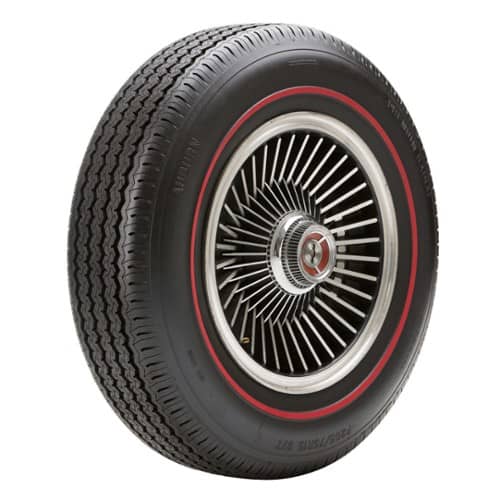
Performance tires for classic cars represent specialized products engineered to push vintage vehicles beyond their original capabilities while maintaining period-appropriate appearance. These tires incorporate contemporary tire technology - advanced compounds, optimized tread designs, and modern construction methods - specifically adapted for classic automobile applications.
Performance tires designed for classic cars combine cutting-edge tire engineering with sizing and styling appropriate for vintage vehicles. The construction incorporates several advanced features:
Modern tread compounds: High-silica rubber formulations provide superior grip in both dry and wet conditions compared to traditional tire compounds. These materials maintain flexibility across wider temperature ranges while resisting wear.
Optimized tread patterns: Computer-designed tread blocks maximize contact patch efficiency while maintaining period-appropriate visual appearance. The patterns balance water evacuation for wet weather capability with maximum dry surface contact for performance driving.
Advanced carcass construction: Dual-ply radial body construction with reinforced steel belt packages provides stability during spirited driving. The robust structure resists deflection under cornering loads while maintaining comfortable ride characteristics.
Reinforced sidewalls: Enhanced sidewall construction improves steering response and cornering stability. The strengthened design resists sidewall flex during aggressive maneuvers while maintaining appropriate ride quality for street driving.
Speed ratings: Performance tires for classics carry higher speed ratings than standard reproduction tires - typically H-rated (130 mph) or V-rated (149 mph) compared to S-rated (112 mph) for conventional classic car tires.
Leading manufacturers produce performance tires specifically engineered for classic vehicles:
Michelin Pilot Sport Classic offers modern performance technology in period-correct sizing. The TB15 line provides track-capable performance for vintage racing applications.
Pirelli P Zero Corsa in Collezione specifications delivers contemporary supercar performance for high-end classic sports cars. The Cinturato line provides balanced street performance with appropriate vintage styling.
BFGoodrich Radial T/A represents a legendary performance tire that bridges classic styling with modern capability. The design maintains authentic 1970s-1980s appearance while incorporating contemporary construction methods.
Performance tires transform classic car driving dynamics through measurable improvements across multiple parameters:
Enhanced wet grip: Modern compounds and optimized tread patterns dramatically improve wet weather traction. Stopping distances in rain can decrease by 15-20% compared to standard classic car tires. Hydroplaning resistance increases significantly through improved water evacuation.
Superior dry handling: The increased contact patch and advanced rubber formulations provide noticeably improved cornering grip. Classic cars equipped with performance tires exhibit sharper turn-in response and higher cornering limits.
Improved stability: Reinforced construction maintains tread stability during aggressive driving. High-speed stability improves through reduced tread squirm and enhanced belt package rigidity.
Better feedback: Performance tires communicate road surface conditions more effectively than standard alternatives. Drivers receive clearer information about available traction and approaching grip limits.
Increased safety margins: The combined benefits of improved grip, shorter braking distances, and enhanced wet weather capability significantly expand safety margins. This proves particularly valuable when driving spiritedly or encountering unexpected situations.
Reduced stopping distances: Contemporary compounds and tread designs decrease braking distances by 10-15 feet from 60 mph compared to standard classic car tires. This improvement can prove critical in emergency situations.
Track capability: Performance tires suitable for occasional track use resist heat buildup and maintain consistent grip during sustained hard driving. Some specifications handle light competition duty without degradation.
The performance improvements prove most dramatic on modified classics. Vehicles with upgraded suspension, increased power output, or enhanced braking systems benefit substantially from tire performance matching their enhanced capabilities.
Performance tires serve classic car enthusiasts whose priorities extend beyond preservation to include dynamic driving enjoyment:
Regularly driven classics: Enthusiasts who drive their classic cars frequently on modern roads benefit from enhanced safety and performance characteristics. The improved wet weather capability alone justifies the investment for regular-use vehicles.
Performance-oriented builds: Classic cars modified with suspension upgrades, brake improvements, or increased power output require tire performance matching their enhanced capabilities. Factory tire specifications become inadequate when vehicle dynamics exceed original parameters.
Resto-mod projects: Builds combining classic appearance with contemporary performance expect modern tire capability. Performance tires complement upgraded mechanicals while maintaining period-appropriate visual presence.
Spirited driving enthusiasts: Owners who enjoy driving their classics enthusiastically on winding roads appreciate the enhanced grip, feedback, and safety margins that performance tires provide.
Mountain and canyon driving: Challenging roads with elevation changes, tight corners, and demanding conditions benefit from superior handling and braking characteristics.
Occasional track events: Classic cars participating in track days, vintage racing, or performance driving schools require tire capabilities exceeding standard specifications. Performance tires provide necessary grip and heat resistance.
Higher-performance classics: Sports cars, muscle cars, and performance-oriented vehicles from any era benefit from tire capabilities matching their intended character. A Shelby Mustang or Porsche 911 deserves tire performance reflecting its sporting heritage.
Performance tires are generally inappropriate for:
Concours-level restorations prioritizing absolute originality
Show cars judged on period-correct authenticity
Vehicles driven infrequently or stored most of the year
Applications where tire appearance must match specific factory equipment
Pricing for performance tires designed for classic cars ranges from approximately $253 to $409 per tire, depending on size, specification, and manufacturer. This premium over standard classic car tires reflects advanced technology, specialized manufacturing, and lower production volumes.
The investment in performance tires pays dividends through transformed driving dynamics and expanded capability. For enthusiasts who regularly drive and enjoy their classic cars, these tires unlock performance potential while maintaining acceptable visual appearance. The enhanced safety margins alone justify the additional cost for vehicles driven regularly on contemporary roads.
This comprehensive comparison chart summarizes the key characteristics, benefits, and considerations for each type of classic car tire discussed in this guide. Use this reference to quickly evaluate which tire type best matches your specific requirements, driving habits, and restoration goals.
Tire Type |
Construction Features |
Performance Benefits |
Best Applications |
Key Characteristics |
Typical Price Range |
|---|---|---|---|---|---|
Bias-Ply |
Multiple diagonal fabric plies at 30-45° angles; typically 4 layers for passenger cars |
High puncture resistance; follows road ruts; higher heat buildup |
Concours restorations; show cars; pre-1975 vehicles |
Squared-off shoulder profile; taller sidewalls; authentic period feel |
Varies by manufacturer |
Radial |
Cords run perpendicular (90°) to travel direction; steel belt construction |
Superior handling; improved fuel efficiency; longer tread life |
Regular driving; highway use; wet weather conditions |
Consistent road contact; better heat management; enhanced stability |
Varies by manufacturer |
Bias-Look Radial |
Modern radial internal construction with traditional bias-ply appearance |
Excellent handling; reduced flat-spotting; better wet weather grip |
Daily-driven classics; show cars used regularly |
Combines vintage esthetics with modern performance |
$262-$440 |
Whitewall/Redline |
Available in both bias-ply and radial construction; decorative sidewall elements |
Performance depends on underlying construction type |
1940s-50s cars (whitewalls); 1960s muscle cars (redlines) |
Decorative sidewall treatments; multiple width options available |
$178-$435 (whitewalls); $800-900 (redlines, complete set) |
Performance |
Modern compounds; high-silica tread; dual-ply carcass construction |
Enhanced wet grip; improved stability; better puncture resistance |
Regular-use classics; performance-oriented builds |
Modern tire technology with period-appropriate appearance |
$253-$409 |
This comparison chart provides the essential information you need to select the right tires for your classic car project. Consider your driving habits, authenticity requirements, and budget when making your final decision.
Choosing the right classic car tires comes down to matching your driving habits with your authenticity goals. We've covered five main tire categories that serve different needs in the classic car world. Bias-ply tires provide genuine period-correct appearance and feel, though they compromise on modern handling. Radial tires deliver superior performance for regular driving but may not suit purists seeking absolute authenticity.
Bias-look radials solve this dilemma by combining vintage looks with contemporary construction benefits. Whitewall and redline tires add distinctive visual appeal regardless of their underlying construction type, making them ideal for show restorations or period-specific builds. Performance tires push classic vehicles beyond original capabilities while maintaining heritage styling elements.
Your tire choice depends on how you enjoy your classic automobile. Show cars benefit from authentic bias-ply designs that judges expect to see. Weekend cruisers perform better with radial or bias-look radial construction that provides safety and comfort. Visual elements like whitewalls or redlines help match your vehicle's original era styling.
Tire selection represents just one part of your classic vehicle's overall appearance and performance package. Explore our wide selection of classic car wheels at Performance Plus Tire to find the perfect complement to your classic car tires. The right wheel and tire combination can completely transform both the look and driving experience of your cherished automobile.
At Performance Plus Tire, we carry the best selection of classic car tires at competitive prices. Our expert team understands that your classic car deserves tires that honor its heritage while meeting your specific driving needs. Whether you prioritize concours-level authenticity or enhanced road performance, we have solutions for every classic car enthusiast.
Ready to find the perfect tires for your classic automobile? The right set of tires awaits - designed to carry your automotive treasure safely and stylishly wherever the road leads.
Understanding the five main types of classic car tires helps you balance historical authenticity with modern performance needs for your vintage vehicle.
Bias-ply tires provide authentic period-correct feel for pre-1975 vehicles but sacrifice modern handling and fuel efficiency for historical accuracy.
Radial tires deliver superior performance, safety, and longevity for regular driving, making them ideal for classic cars used frequently on modern roads.
Bias-look radials offer the perfect compromise, combining vintage esthetics with modern radial construction for both show quality and improved drivability.
Whitewall and redline tires serve as decorative styling elements that can be applied to any construction type, with costs ranging from $178-$900 per set.
Performance tires maximize handling capabilities using modern compounds while maintaining period-appropriate appearance, though at premium prices of $253-$409 per tire.
The right tire choice depends on your driving habits—show cars benefit from authentic bias-ply designs, while weekend cruisers perform better with radial or bias-look radial construction. Consider that tire prices vary significantly based on construction type and decorative features, so budget accordingly for your restoration project.
Several manufacturers offer tires specifically designed for classic cars. Some well-known brands include Coker Tire, Michelin, Pirelli, BFGoodrich, and Firestone. These companies produce both authentic reproductions and modern tires with vintage styling.
Bias-ply tires have a crisscross internal structure and provide an authentic vintage feel, but offer less stability and wear faster. Radial tires have a perpendicular cord structure, providing better handling, fuel efficiency, and longevity, but may not look period-correct on some classics.
Yes, whitewall tires are still produced for classic cars. They come in various widths and can be found in both bias-ply and radial constructions. Companies like Coker Tire and Diamond Back specialize in manufacturing whitewall tires for vintage vehicles.
Bias-look radial tires combine modern radial construction with the appearance of traditional bias-ply tires. They offer improved performance and longevity while maintaining a period-correct look, making them a popular choice for classic car owners who drive their vehicles regularly.
Consider factors such as how often you drive the car, whether authenticity or performance is more important to you, and your budget. For show cars, bias-ply tires may be preferred for historical accuracy. For regular driving, radial or bias-look radial tires often provide a better balance of performance and vintage esthetics.